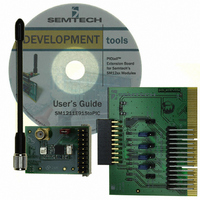SM1211E915TOPIC Semtech, SM1211E915TOPIC Datasheet - Page 52

SM1211E915TOPIC
Manufacturer Part Number
SM1211E915TOPIC
Description
KIT PICTAIL EXT FOR SX1211
Manufacturer
Semtech
Type
Transceiver, UHFr
Specifications of SM1211E915TOPIC
Frequency
915MHz
For Use With/related Products
SX1211
Lead Free Status / RoHS Status
Lead free / RoHS Compliant
By default, if the CRC check is enabled and fails for the current packet, then the FIFO is automatically cleared and
neither of the two interrupts are generated and new packet reception is started. This autoclear function can be
disabled via PKTParam_CRC_autoclr bit and, in this case, even if CRC fails, the FIFO is not cleared and only
Payload_ready IRQ source is asserted.
Once
PKTParam_Fifo_stby_access. At the end of the reception, although the FIFO automatically stops being filled, it is
still up to the user to explicitly exit Rx mode if required. (e.g. go to Stby to get payload). FIFO must be empty for a
new packet reception to start.
SX1211’s packet handler offers several mechanisms for packet filtering ensuring that only useful packets are made
available to the uC, reducing significantly system power consumption and software complexity.
Sync word filtering/recognition is automatically enabled in Packet mode. It is used for identifying the start of the
payload and also for network identification. As previously described, the Sync word recognition block is configured
(size, error tolerance, value) via RXParam_Sync_size, RXParam_Sync_tol and SYNCParam configuration
registers. This information is used, both for appending Sync word in Tx, and filtering packets in Rx.
Every received packet which does not start with this locally configured Sync word is automatically discarded and no
interrupt is generated.
When the Sync word is detected, payload reception automatically starts and Sync IRQ source is asserted.
Address filtering can be enabled via the PKTParam_Adrs_filt bits. It adds another level of filtering, above Sync
word, typically useful in a multi-node networks where a network ID is shared between all nodes (Sync word) and
each node has its own ID (address).
Three address based filtering options are available:
Please note that the received address byte, as part of the payload, is not stripped off the packet and is made
available in the FIFO. In addition, Node_Adrs and Adrs_filt only apply to Rx. On Tx side, if address filtering is
expected, the address byte should simply be put into the FIFO like any other byte of the payload.
In variable length Packet mode, PKTParam_Payload_length must be programmed with the maximum length
permitted. If received length byte is smaller than this maximum then the packet is accepted and processed,
otherwise it is discarded.
Rev 7 – Sept 2
ADVANCED COMMUNICATIONS & SENSING
Adrs_filt = 01: Received address field is compared with internal register Node_Adrs. If they match then the
packet is accepted and processed, otherwise it is discarded.
Adrs_filt = 10: Received address field is compared with internal register Node_Adrs and the constant 0x00. If
either is a match, the received packet is accepted and processed, otherwise it is discarded. This additional
check with a constant is useful for implementing broadcast in a multi-node networks.
Adrs_filt = 11: Received address field is compared with internal register Node_Adrs and the constants 0x00 &
0xFF. If any of the three matches, then the received packet is accepted and processed, otherwise it is
discarded. These additional checks with constants are useful for implementing broadcast commands of all
nodes.
fully
5.5.5. Packet Filtering
nd
, 2008
received,
5.5.5.1. Sync Word Based
5.5.5.2. Address Based
5.5.5.3. Length Based
the
payload
can
also
Page 52 of 92
be
fully
or
partially
retrieved
in
Stby
www.semtech.com
SX1211
mode
via












